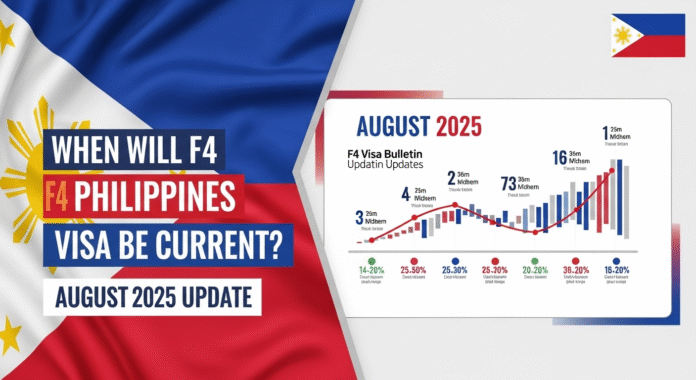For over 400,000 Filipino siblings of U.S. citizens trapped in immigration backlogs, the F4 visa wait represents a 19+ year separation from families. The August 2025 Visa Bulletin confirms minimal movement in this category, maintaining a Final Action Date of January 1, 2006 – identical to July 2025. This stagnation signals one of the most prolonged waits in family-based immigration. Here’s what every Filipino applicant needs to know about timelines, strategies, and critical next steps.
1. Current F4 Philippines Visa Bulletin Status: August 2025
The U.S. Department of State’s latest data reveals:
- Final Action Date: January 1, 2006 (no movement from July 2025)
- Dates for Filing: January 8, 2008 (enables document submission to NVC)
What this means:
Only applicants with priority dates before January 1, 2006 can currently receive green cards. All others remain in a queue stretching back to the early 2000s.

Historical Movement (Recent Months):
| Month | Final Action Date | Movement |
|---|---|---|
| April 2025 | January 1, 2005 | Baseline |
| May 2025 | June 1, 2005 | +5 months |
| August 2025 | January 1, 2006 | +7 months over 4 months |
*Source: U.S. Visa Bulletins *
2. Why the F4 Philippines Backlog Exceeds 19 Years
Three structural factors create this extreme delay:
- Per-Country Caps: U.S. law limits the Philippines to 7% of family-sponsored visas annually (~25,620).
- Demand-Supply Imbalance: The Philippines has the highest F4 applicant volume globally, with 78,000+ pending cases.
- Visa Allocation Math: Only 65,000 F4 visas exist yearly worldwide, shared across all countries. With 5.6M+ applicants waiting, the Philippines receives just 5,000-7,000 annually.
3. Realistic Timeline Projections for Filipino Siblings
Based on current visa usage rates and priority date distribution:
| Your Priority Date | Estimated Green Card Availability | Current Wait |
|---|---|---|
| 1995-2000 | 2025-2027 | 25-30 years |
| 2001-2005 | 2028-2032 | 23-27 years |
| 2006-2010 | 2033-2040+ | 23-34 years |
| 2011-Present | 2040+ | 29+ years |
Critical Notes:
- These projections assume no retrogression (backtracking of dates). High demand could worsen waits.
- Historical average movement is 1-4 months per year, making this among the slowest-moving categories.

4. Strategic Actions Based on Your Priority Date
A. If Priority Date is Before January 1, 2006:
Immediate Steps:
- Submit all civil documents to the National Visa Center
- Complete Form DS-260
- Schedule medical exams with USCIS-authorized physicians
Interview Prep:
- Gather original birth/marriage certificates
- Obtain police clearances from all countries resided in since age 16
B. If Priority Date is Between 2006-2008:
Leverage Dates for Filing:
- Submit supporting documents to NVC now (requires priority date before January 8, 2008)
Prevent Age-Outs:
- Use the Child Status Protection Act (CSPA) to lock in children’s ages under 21
C. If Priority Date is After 2008:
Petitioner Longevity Planning:
- Ensure U.S. citizen siblings maintain U.S. domicile
- Update contact information with USCIS via Form I-865
Explore Alternative Pathways:
- EB-3 Skilled Worker visas (current for Philippines)
- EB-5 Investor visas (no backlog for Philippines)
5. Why Dates Moved Only 7 Months in 2024-2025
The F4 Philippines category shows severe congestion:
- Movement Since April 2025: 12 months (Jan 2005 → Jan 2006)
- Annual Visa Usage: Consistently exceeds supply by 300%
- Retrogression Risk: High in Q4 (Sep 2025) if demand spikes
“The 19-year wait for Filipino siblings reflects systemic flaws in immigration quotas. Unless Congress reforms per-country caps, families will remain separated into the 2040s.” – Immigration Attorney Analysis
6. Legislative Updates: Potential Relief on the Horizon
Two developments could shorten waits:
Dignity Act (H.R. 3599):
- Proposes eliminating per-country caps for family categories
- Could reduce Philippine waits by 6-8 years
Visa Recapture Bills:
- Would reuse unused visas from past years (estimated 226,000 available)
Stakeholder Action: Contact Philippine Embassy advocacy groups to support these bills.
7. Critical Documentation Checklist
Avoid delays by preparing:
Primary Documents:
- NBI Clearance (valid 1 year)
- PSA-authenticated birth/marriage certificates
- Petitioner’s proof of U.S. citizenship (naturalization certificate/US passport)
Financial Evidence:
- Form I-864 Affidavit of Support with IRS tax transcripts
- Petitioner’s current employment letter
Status Tracking:
- Check case status via CEAC State Department Portal
- Subscribe to Visa Bulletin email updates
8. The Emotional Toll: Coping With Prolonged Separation
- Communication Strategies: Use apps like GCash-integrated Messenger for affordable calls
- Emergency Visits: Apply for B-2 tourist visas with evidence of strong home ties
- Community Support: Connect with organizations like Philippine American Bar Association
9. Frequently Asked Questions (August 2025)
Q1: Can I speed up my F4 Philippines application?
A: No. Premium processing unavailable. Focus on document readiness to avoid RFEs.
Q2: What if my petitioner dies during the wait?
A: File Form I-360 as surviving sibling if beneficiary resides in U.S.
Q3: Do grandchildren qualify under my petition?
A: No. Derivative benefits only apply to spouses/children under 21.
Wrapping Up The Whole Story
With 19 years and counting, F4 Philippines waits demand strategic endurance. While current projections suggest 2006-2010 filers may see approvals in 2033-2040, three actions are non-negotiable:
- Monthly Monitoring: Track dates via official Visa Bulletin
- Document Perfection: Eliminate checklist delays with PSA-certified documents
- Advocacy Engagement: Support legislative reforms through US-Philippines Immigration Alliance
“For Filipino families separated since the early 2000s, the F4 backlog represents stolen decades. While legal options are limited, meticulous preparation ensures you’ll be ready when your date finally comes.” – Passage Immigration Law
Disclaimer: Visa policies change rapidly. Verify dates using the August 2025 Visa Bulletin. For case-specific guidance, consult an accredited immigration attorney.
